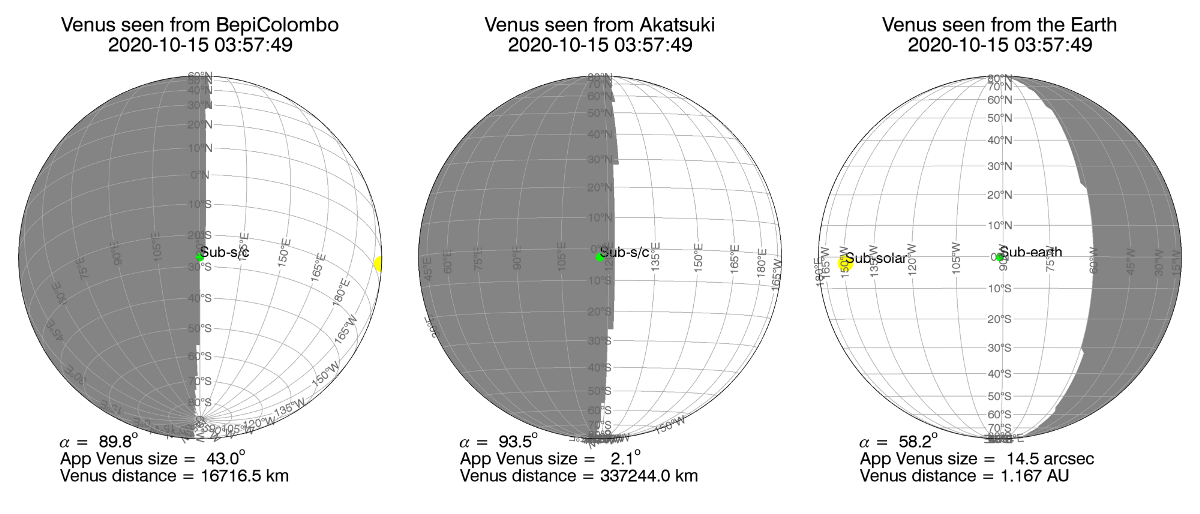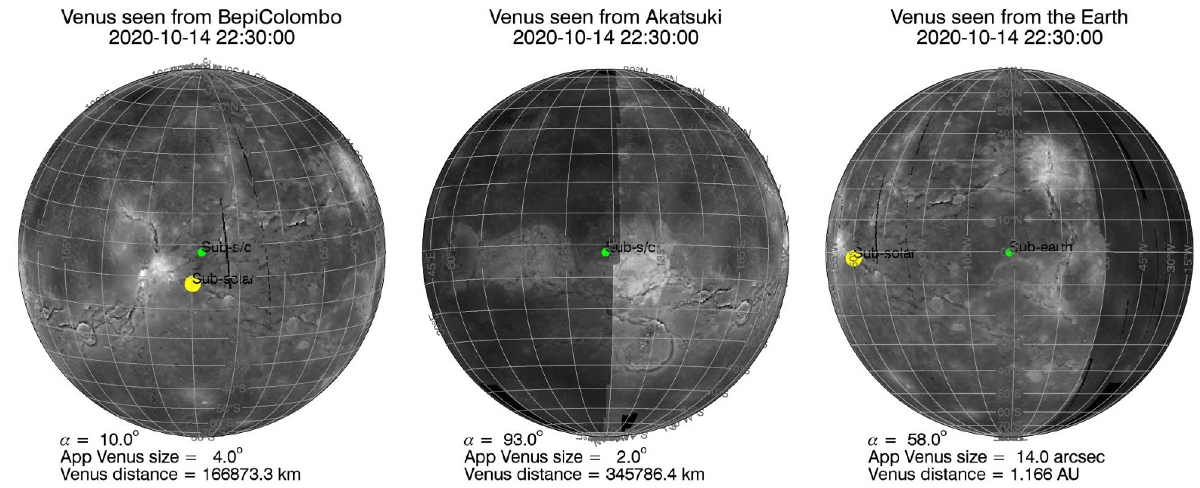| BepiColombo 1st Flyby of Venus by Ricardo Hueso Alonso |
Next week the BepiColombo mission will flyby Venus at an altitude of 10,720 km above Venus surface. It will observe the planet from 13 October to 17 October with a closest approach on 15 October at 03:58 UT. This will be the first of two flybys to Venus, with the second one scheduled for 10 August 2021 at a very close altitude of 550 km. We would like to invite you to get Venus observations over these days and up to October 21 with emphasis on the closest approach of 15 October. Venus cloud tops observable in the UV rotate around the planet once every 4 days and observations from 11-12 October will characterize the details observable at the time of the closest flyby on 15 October. Observations on 19-20 will be able to characterize the next rotation. Long infrared filters (IR810, methane filters and 1000nm) can be used to study the dynamics of lower levels of the clouds where the atmosphere rotates once every 5 days and where large structures recently discovered and not yet fully understood can be observed (see for instance the following observations from Manos Kardasis from March 2020: http://pvol2.ehu.eus/pvolimages/venus/v2020-03-21_17-42_uv_mk.jpg) We warmly invite you to get observations that will help us characterize motions, cloud morphology and changes in Venus cloud fields over the time scale of 2-3 rotations around the planet (8-13 days). Some of you have obtained fantastic observations of Venus surface with combinations of filters close to 1 micron isolating the narrow bands at 1.0, 1.05 and 1.1 microns where the surface becomes observable. Such observations are also highly welcomed. BepiColombo will observe Venus thermal emissions from 7 to 14 microns obtaining global images of the temperatures at the cloud tops and above the clouds and will obtain detailed spectroscopy in the UV from 145 to 315 nm. Images in the UV and 10 microns (also reflecting thermal properties of the atmosphere at the upper clouds and above) will be obtained by the Akatsuki orbiter. The amateur contribution might provide most of the temporal context of the cloud fields to the BepiColombo spectra and will be very valuable to the mission. More information here: http://pvol2.ehu.eus/bc/Venus/ https://www.cosmos.esa.int/web/bepicolombo-flyby/venus1flyby I send recent examples of Venus observations from experienced observers Raimondo Sedrani and Luigi Morrone in Italy and two schematic plots of the regions that will be observed from BepiColombo, Akatsuki and ground-based observers. I would also like to express my gratitude to Venus observers over this summer providing a long time-reference for the interpretation of these observations.

来週、ベピコロンボミッションは金星の表面から10,720kmの高度で金星を通過します。10月13日から10月17日まで金星を観測し、10月15日03:58UTに最接近します。 これは金星への2回のフライバイの最初のもので、2回目は2021年8月10日に550kmの非常に近い高度で予定されています。 10月15日の最も近いアプローチに重点を置いて、これらの日から10月21日までの金星の観測を取得することをお勧めします。 UVで観測可能な金星の雲頂は、4日に1回惑星の周りを回転し、10月11日から12日までの観測が特徴的です。10月15日の最も近いフライバイの時に観察可能な詳細です。 19-20の観測は、次のローテーションを特徴づけることができるでしょう。遠赤外線フィルター(IR810、メタンフィルター、1000nm)を使用して、低レベルの雲のダイナミクスに研究できます。 金星の大気は5日に1回転し、最近大きな地形が発見された場所などまだ完全には理解されていないことが観察できます (たとえば、2020年3月のManos Kardasisによる次の観測を参照してください: http ://pvol2.ehu.eus/pvolimages/venus/v2020-03-21_17-42_uv_mk.jpg) 金星大気動きや雲の形態を特徴づけるのに役立つ観測をぜひご利用ください。金星の周りを2〜3回転する時間スケール(8〜13日)での金星の雲のフィールドの変化。 あなた方の何人かは、狭いバンドを分離する1ミクロンに近いフィルターの組み合わせで金星表面の素晴らしい観測を得ました 表面が観察可能になる1.0、1.05および1.1ミクロンで。このような観察も大歓迎です。 BepiColomboは、7〜14ミクロンの金星の熱放射を観測し、雲頂の温度のグローバル画像を取得します。雲の上にあり、145〜315nmのUVで詳細な分光法を取得します。 アカツキオービターは、UVと10ミクロン(上層雲以上の大気の熱特性も反映)の画像を取得します。 アマチュアの貢献は、雲のフィールドの時間的コンテキストのほとんどをBepiColomboスペクトルに提供する可能性があり、ミッションにとって非常に価値があります。 詳細はこちら: http://pvol2.ehu.eus/bc/Venus/ https://www.cosmos.esa.int/web/bepicolombo-flyby/venus1flyby イタリアの経験豊富な観測者ライモンドセドラニとルイージモローネからの金星観測の最近の例と、ベピコロンボ、アカツキ、および地上観測者から観測される地域の2つの概略プロットを紹介します。 また、この夏の金星の観測者に、これらの観測の解釈のための長い時間の参考資料を提供してくれたことに感謝の意を表したいと思います。
ALPO-Japan Latest
Venus Section